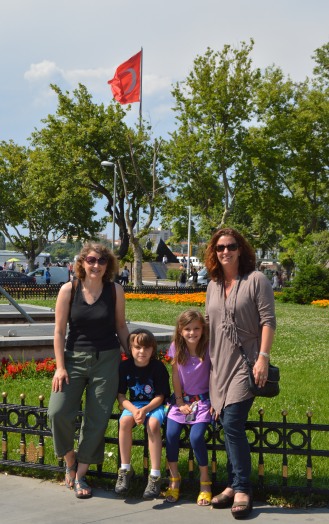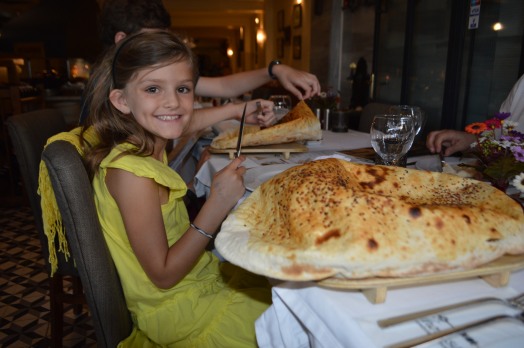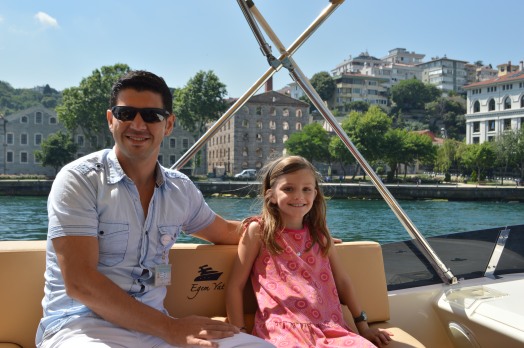This was it, a final trip, during a year of almost endless travel. While we were clearly fortunate for the experience, the kids were ready for stability. Normally, they would long for the long weekend (who doesn’t?), but not in Barcelona, because that meant leaving town and the comforts of home, and likely a museum or tour. Of course, the standard line from everyone is, “they will appreciate it someday….”
It was June, and we were finished with the long weekends, but there was one last excursion before crossing the Atlantic. BCN to Istanbul direct and we were at Boutique St. Sophia Hotel by 11:00 a.m. on June 21, and soon after testing the Turkish meatballs.
A midday ferry took us to the Asian side of Istanbul, to Kadıköy, where we were greeted by Evelyn’s college friend, Aninne Schneider, and her sons Teo and Sinan. We crossed the street to Güllüoğlu for baklava and Turkish Delight and then wandered the local market before returning on the ferry. I captured these olives on film, not realizing yet that these would be a staple in Turkey, at breakfast, lunch and dinner.
with Aninne and Teo…
 Back near our hotel, it was time for a Turkish bath at Ayasofya Hürrem Sultan Hamamı, built in 1556. Max and I were separated from the women and all of us were scrubbed, covered with bubbles, and massaged while lying on towels on the hard marble floor in a setting that made me feel as if I was living several hundred years earlier.
Back near our hotel, it was time for a Turkish bath at Ayasofya Hürrem Sultan Hamamı, built in 1556. Max and I were separated from the women and all of us were scrubbed, covered with bubbles, and massaged while lying on towels on the hard marble floor in a setting that made me feel as if I was living several hundred years earlier.
Later we met Aninne and family in the Levant neighborhood at Namlı Kebap to taste traditional Turkish fare and to watch Argentina score late to avoid a tie with Iran.
Our guide, Murat Kaya (guide_mr@hotmail.com) met us at our hotel on our second day and explained the bandaged heads of guests at whom we were staring during breakfast; apparently Istanbul offers very cheap hair transplants.
We walked to the Hippodrome, which was one of the largest chariot race grounds of the Byzantine Empire. The Obelisk of Theodosius, within the Hippodrome, was brought to Constantinople from Egypt in the 4th century AD.
At the Sultan Ahmed Mosque (known as the Blue Mosque, given blue tiles covering the walls), built in the early 17th century, we donned the necessary garb to enter. The mosque has six minarets, which equaled the number at the mosque in Mecca at the time of construction, apparently not pleasing some; so, the Sultan had a seventh minaret added in Mecca.
The 15th century Topkapı Palace was the residence of the sultan, his court, and harem, and a total of 4,000 people, as well as the government seat for the Ottoman Empire.
MEM posed outside the Treasury section, which houses the 7th largest diamond in the world, the “Spoonmaker’s Diamond”.
…on the palace grounds…
After lunch at the popular Lale Restaurant, known as “The Pudding Shop”, we visited St. Sophia. Completed in 537 under Emperor Justinian, it took just five years to build, using 10,000 unskilled slaves and 1,000 master craftsmen. The dome is the 4th largest in the world, according to Murat, after St. Peter’s, St. Paul’s and the Duomo. Hagia Sophia remained a Christian structure until conversion into a mosque in 1453; the first president of Turkey, Atatürk, made it a museum in 1934.
 We ended the day with a visit to the Underground Cistern, a vast space of approximately 70 meters by 140 meters, built by Justinian in the 6th century as a water storage site for the Great Palace and other buildings.
We ended the day with a visit to the Underground Cistern, a vast space of approximately 70 meters by 140 meters, built by Justinian in the 6th century as a water storage site for the Great Palace and other buildings.
There are 336 columns supporting the roof, including two with the head of Medusa at the base.
Our favorite restaurant in Istanbul was Khorasani, which served delicious lavash, kebabs and salads.
 Hagia Sophia in the background…
Hagia Sophia in the background…
 After dinner we enjoyed tea and another World Cup game outdoors while on comfortable cushions.
After dinner we enjoyed tea and another World Cup game outdoors while on comfortable cushions.
 We kicked off another day in Istanbul with a cruise on the Bosphorus, the strait of water separating Asia and Europe.
We kicked off another day in Istanbul with a cruise on the Bosphorus, the strait of water separating Asia and Europe.
Maggie with Murat…
At the 11th century Church of St. Saviour in Chora, we saw beautiful mosaics with various Mary and Jesus scenes.
At the Spice Market, this brilliant salesman (the store was handpicked by Murat of course) suckered us into purchasing a large amount (rather, a large price) of nuts and Turkish Delight.
After lunch at Hamdi Restorant overlooking the water, we took in a spectacular view from the 14th century Galata Tower (elevator up, walk down), which was the tallest structure in the city for several centuries, at 66.90 meters from the ground and 140 meters from sea level.
Hagia Sophia and Blue Mosque in the distance…
 Sea Song Tours planned much of our trip, and the company owner’s husband has a large carpet business in Istanbul. So, where would we shop for carpets? Murat led (forced) us to Orient Handmade Carpets, where we were given a demonstration of carpet making followed by a strong and admirable sales pitch. When you really don’t want or need a carpet, the prices fall dramatically, but we still walked away empty handed and happy, even after about 30 rugs were rolled out for us to view; Evelyn’s various comments (“we would want something lighter”) didn’t help our plans for a quick visit!
Sea Song Tours planned much of our trip, and the company owner’s husband has a large carpet business in Istanbul. So, where would we shop for carpets? Murat led (forced) us to Orient Handmade Carpets, where we were given a demonstration of carpet making followed by a strong and admirable sales pitch. When you really don’t want or need a carpet, the prices fall dramatically, but we still walked away empty handed and happy, even after about 30 rugs were rolled out for us to view; Evelyn’s various comments (“we would want something lighter”) didn’t help our plans for a quick visit!
Our last stop of the day was the Grand Bazaar and its 4,000 shops, a massive operation, although there really appeared to be only about 10 different stores in total, each with many variations throughout the covered bazaar. The girls came away with key chains and Evelyn a purse.
For our third and final dinner, we found Fuego near our hotel, ranked #4 out of almost 11,000 restaurants on Trip Advisor, an apparent victory for us. Spain was playing its final World Cup game, against Australia, and while meaningless, we were hoping for a glimpse, yet no t.v. viewing available. Sadly, Spain’s futbol underperformance compared to that of Fuego; even the enticing Chocolate Volcano which each kid devoured was too cakey and without the expected strong flow of lava.










